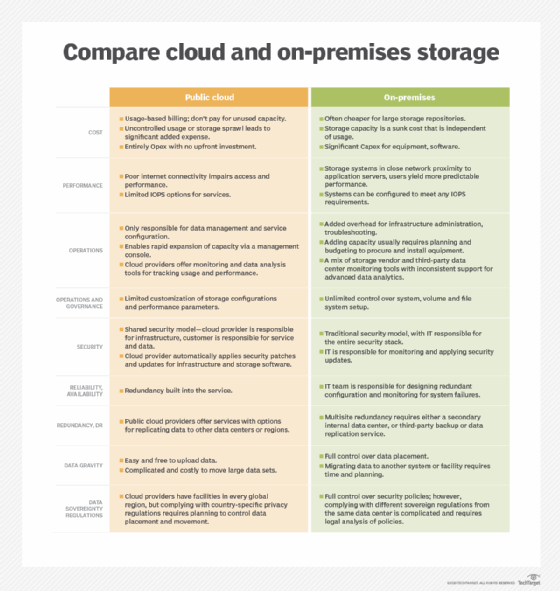
Getty Images
Cloud computing's real-world environmental impact
As more companies amp up their reliance on cloud computing, they may overlook its environmental impact. Here's why that's a bad idea.
Cloud computing may sound wispy, but its environmental effects are very real.
The cloud consumes significant volumes of energy, water and other natural resources, produces a significant volume of greenhouse gas (GHG) emissions and generates vast amounts of electronic waste (e-waste). Moreover, its negative impact on sustainability is set to grow, as society's ever-growing demand for computing power drives the need for more cloud computing capacity.
As a result, the environmental impact of cloud computing is drawing greater scrutiny, as cloud providers and business and IT leaders consider whether to act and what actions to take.
"There has been a surge in growth in [cloud computing] data centers over the past decade, and with the growing use of artificial intelligence, we're seeing yet another acceleration in the growth of cloud data centers to support these very compute-intensive workloads," said Ed Anderson, vice president and distinguished analyst with Gartner.
This growth has a good and a bad side, according to Anderson. The positive: Cloud providers are building data centers with advanced technologies that use sustainable power and efficient cooling systems. The negative: These data centers require a lot of resources, which can delay businesses from reaping the benefits of the advanced technologies.
The environmental impact of cloud computing
The pressure is on for cloud providers to become more sustainable, said Katia Chaban, vice president and head of the Sustainability Center of Expertise for Global IT at NTT Data, an IT service management company. With compute resources increasingly provided by cloud companies -- including hyperscalers like Google, IBM, Microsoft and Oracle -- the environmental impact of computing has become much more front and center, Chaban said.
Companies and organizations with cloud workloads have their own environmental, social and governance (ESG) goals to meet, which are influenced by consumers, investors, corporate leaders and regulators. As a result, organizations push cloud providers to limit their environmental impact so they can meet their ESG objectives.
Those same companies and organizations also want to keep their costs in check. Environmentally efficient cloud operations can help with that, which adds more pressure to cloud providers to deliver on sustainability.

To start, enterprise leaders are more aware today that cloud computing requires massive amounts of energy, and energy production itself has an environmental footprint, Chaban said. Although the cloud sounds ethereal, it runs on hardware, cables, fans, servers, storage arrays, routers, switches, computers, rare metals and other real-world elements.
The International Energy Agency's 2025 "Energy and AI" report details the growth of data centers and their energy needs. It noted that data centers in 2024 accounted for around 1.5% of the world's electricity consumption, which has grown around 12% per year since 2017 -- more than four times faster than the rate of total electricity consumption. That, in turn, produces significant GHG emissions.
Cloud computing facilities and data centers need electricity to power hardware and building operations -- most notably, air conditioning to keep machines cool, said Ian Grobel, managing director of technology consulting at professional services firm EY. The "2024 United States Data Center Energy Usage Report" from Lawrence Berkeley National Laboratory estimated that hyperscale data centers in the U.S. will consume between 60 and 124 billion liters of water in 2028. That has increased since 2014, when all data centers -- both cloud and on-premises -- consumed 21.2 billion liters of water.
Additionally, cloud computing facilities require large tracts of land. Cloud providers often build facilities in geographies that minimize the environmental impact in one way, but could exacerbate other effects, Grobel said. For example, they may build data centers in desert-like areas to add solar arrays that power their facilities, or locate them in chillier climates to lower cooling requirements. Yet, those decisions may mean more intensive needs elsewhere, such as stressing water supplies in desert locales or building in greenfield sites in cooler climates.
Discarded data center equipment also affects the environment, as it contributes to the growing mounds of e-waste accumulating worldwide. According to the United Nations' 2024 Global E-Waste Monitor, the world produced 62 million tons of e-waste in 2022, up 82% from 2010. The volume of e-waste produced is expected to hit 82 million tons in 2030.
How AI affects cloud computing's environmental impact
As previously noted, the increased use of AI has driven up the use of cloud computing resources, which in turn intensifies the cloud's stress on the environment.
To start, training and deploying large AI models require immense computational power, which is nearly always done in the cloud and leads to soaring electricity consumption and more GHG emissions.
"The demands of AI are driving an explosion in the computer power that is needed," Grobel said.
In fact, business leaders are prioritizing the need to quickly adopt and innovate with AI over the need to use AI more sustainably, Grobel said. However, he said that will change as enterprise and consumer use of AI matures. Then, organizations will likely optimize how they train and run AI models, motivated to keep their cloud computing and energy costs in check, to meet regulatory sustainability requirements and to limit their environmental footprint.
Environmental effects of cloud computing vs. on-premises
Although cloud computing has a significant environmental impact, the cloud is more efficient and runs more sustainably than on-premises data centers -- that is, data centers owned and managed by individual organizations.
Specifically, hyperscalers can build and manage data centers more sustainably than an individual organization can with its own on-premises data center, Grobel said. Hyperscalers can build data centers in locations that minimize their environmental impact, such as in cooler climates to reduce the energy or water needed to cool the equipment. They can also hire more expert staff to design and manage large data centers efficiently, like optimizing resources and minimizing the number of idle machines that waste electricity.
Organizations that run their own on-premises compute resources don't have the same ability to design and run facilities as cloud providers.

Cloud providers are also more equipped to invest in new data center technologies, which are more resource-efficient, according to Paul Schuster, NTT Data's head of North American Sustainability. For example, the use of liquid immersion cooling and more efficient chips can improve data centers' sustainability. Cloud providers also look to use silicon photonics instead of electrical signals for data transfer, seeing photonics as a way to improve performance and lower power consumption.
Additionally, cloud providers can negotiate with energy providers to get more energy from renewable sources and establish direct links to production sources, which limits the energy loss during transmission, Anderson said. Cloud providers are also investing in nuclear energy -- a low-carbon energy source -- to get additional power without increasing GHG emissions.
"The hyperscalers can build in efficiencies that are difficult for a corporate data center to achieve," Anderson said.
Research firm IDC estimated the movement away from on-premises to cloud computing prevented more than 1 billion metric tons of carbon dioxide emissions from 2021 through 2024, in part due to the greater efficiency of aggregated computing resources. Cloud computing is primed to become even more efficient, as many cloud providers have publicly pledged to reduce their environmental impact. However, the data from hyperscalers isn't as granular, transparent and accessible as it could be, Chaban said.
How to reduce cloud computing's environmental impact
Given the lack of transparent, granular data, business and IT leaders attempting to base their decisions on sustainable procurement and vendor choices need to assess green claims more closely, Chaban said.
Other actions that organizations can take include the following:
- Optimize workloads. Right-size the compute resources required for the workload. Avoid overprovisioning by scaling compute and storage resources to actual demand. Schedule tasks during off-peak hours or when renewable energy is most available, if possible.
- Scrutinize cloud providers. Seek providers that use renewable energy and have implemented newer, more efficient cooling systems and modern, high-efficiency hardware and infrastructure. If possible, place workloads in data centers that have lower environmental impacts.
- Monitor and report relevant data. Work with cloud providers to increase the transparency and granularity of data they gather and provide to gain a more accurate calculation of the environmental impact of specific data center workloads.
Editor's note: This article was originally published in 2023 and was updated to reflect changes in cloud computing and sustainability best practices.
Mary K. Pratt is an award-winning freelance journalist with a focus on covering enterprise IT and cybersecurity management.







